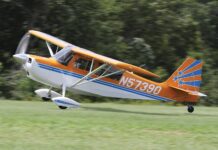One of the first things primary students learn in their training is the relationship of airspeed to stalls. Unfortunately, the Primacy Law can take over, leaving some pilots with the unshakable belief stalls only can happen at stalling speed, either clean (VS/VS1) or in the landing configuration (VS0). That’s basically true in 1g flight but not if any additional loading is placed on the wings, as often is the case when we’re maneuvering. In that situation, stall speed increases, sometimes dramatically.

Eventually, we learn a wing will stall when we exceed its critical angle of attack, no matter what the airspeed indicator says. In training, such a stall often is referred to as “accelerated.” It’s used, in part, to demonstrate what we may have learned in Groundschool 101 ain’t necessarily all there is to know about stalls. While it should be obvious an accelerated stall can occur with little warning, it’s perhaps not obvious we can encounter one anytime we’re maneuvering. The accident record associated with maneuvering flight suggests a review is in order.
LOC Outcome
And the maneuvering doesn’t have to be violent or abrupt. On July 22, 2015, a Piper PA-46-310P Malibu crashed while executing a descending close-in turn from downwind to final at Oshkosh, Wis. According to the NTSB, “The pilot continued the approach and about 250 to 300 ft above ground level, he pulled back on the power which resulted in the airplane entering a stall.” The airplane’s bank angle was described as “steep.”
That’s pretty far from what many of us may think of when discussing accelerated stalls. In fact, an accelerated stall can be a natural outcome of turning flight, or anytime we’re pulling greater than 1g. That includes raising the nose at the bottom of a loop, dive or level-off maneuver, if it’s performed too abruptly and imposes too much load on the wing. That’s possibly what happened with the Malibu: During the steep descending turn, the pilot increased back pressure on the yoke, raising the nose and increasing wing g-loading. That the airplane was in a bank certainly didn’t help and may have increased g-loading asymmetrically—see the sidebar on page 14.
This is an example of maneuvering flight, and the stalls that can result cause us to lose control of the airplane. As the FAA and the industry-based General Aviation Joint Steering Committee (GAJSC) have spent years documenting, loss of control (LOC) events are a major cause of fatal accidents.
While LOC awareness is greater than ever, and mitigations like angle of attack (AoA) indicators are important to prevention, the basic concept is this: Anytime we’re not in straight-and-level, 1g flight, the potential for an accelerated or maneuvering stall increases. That’s why they’re called maneuvering stalls.
High-G Maneuvering
The FAA’s Airplane Flying Handbook (or AFH, FAA-H-8083-3B) reiterates a point we made at the beginning: “At the same gross weight, airplane configuration, and power setting, a given airplane will consistently stall at the same indicated airspeed if no acceleration is involved.” But that stalling airspeed will be greater “when excessive maneuvering loads are imposed by steep turns, pull-ups, or other abrupt changes in its flightpath.” Such stalls “tend to be more rapid, or severe,” and because they “occur at higher-than-normal airspeeds, and/or may occur at lower than anticipated pitch attitudes,” pilots may not expect them.
What kind of flying are we talking about here? “Most frequently it would occur during improperly executed steep turns, stall and spin recoveries, and pullouts from steep dives,” says the AFH. Such a stall, the FAA continues, may “be encountered any time excessive back-elevator pressure is applied and/or the angle of attack is increased too rapidly.” In other words, any time we’re engaged in maneuvering flight, the risk of such a stall increases.
Perhaps a classic example would be showing off, either to people on the ground or a passenger. We might call it the “hey, watch this” kind of accident. A high-speed pass is executed, followed by a high-deck-angle climb and a steep turn. Another example might be when we’re flying slowly, perhaps relatively close to the ground, and enter a level steep turn to look more closely at a terrain feature. In both cases, all that’s necessary to enter such a stall is to load up the wing at a slow airspeed, as when in a turn or pulling out of a dive.
Of course, the airplane’s weight should be considered when discussing the likelihood of a stall while maneuvering. For a given airplane, the lighter it is, the lower will be the speed at which it stalls in a normal, 1g event. In other words, the airplane will stall at a lower-than-published speed if we keep it light. The same is true when at higher g loading, also—we might get away with some high-g maneuvers without stalling if the airplane is light.
Conversely, when loaded to its gross weight, an airplane will enter a straight-ahead stall at the published airspeed (calibrated, by the way, not indicated). The moral is we don’t want to load up with fuel and people, then go out and demonstrate steep turns at 500 feet agl unless we actually want to lose control.

The Numbers
The math of all this is briefly explained in the sidebar on the opposite page. The first bit of information, the table listing bank angles and load factors, is something with which you already should be familiar. The table’s values apply to any airplane, and as the bank angle approaches 90 degrees, the load factor approaches infinity. Yes, we can bank to 90 degrees in level flight, and beyond, but we can’t do it, in any airplane, without losing altitude.
The relationship of bank angle to load factor can be deceiving, however. As mentioned earlier, that’s because we don’t need a bank to increase the airplane’s load factor—it can be accomplished in straight-and-level flight. Perhaps the best example is the seat-of-the-pants feeling we get when cruising through turbulence. Those momentary up- and downdrafts are loading and unloading the airplane just as they are its occupants. Too much turbulence, in excess of the airplane’s maximum load factor, will have one of two outcomes, depending on the airplane’s speed. If at or (preferably) below the airplane’s maneuvering speed (VA), it will stall, at a speed well above VS. Above that value, the structural damage can occur.
The point is that stalling speed increases with g-loading, not bank angle. Bank angle is simply a common way we impose load. An abrupt climb—as we might perform to pull out of a dive, or to miss a looming obstacle—also imposes g-loading. Pull the nose up sharply and steeply enough, and the airplane will stall.

But what if quickly increasing the airplane’s pitch means the difference between flying another day or hitting a tree? First, level the wings; asymmetrically loading them overly complicates a pull-up maneuver and risks a stall or airframe failure where a wings-level effort won’t. Then, pull smoothly—a sharp, immediate pitch increase can result in the maneuvering stall we’re trying to avoid.
How much to pull is a function of how small you need the radius of your pull-up maneuver to be. It’s something best determined during a series of test flights with a g-meter, but approximating the 2g we experience in a level 60-degree banked turn might be a good rule of thumb. From the sidebar above, we learned imposing 2g on an airplane with a 55-knot VS increases stalling speed to 78 knots.
The ideal, of course, is not being in a situation where we need to transition from level flight or a dive to a climb in order to save the airplane.
Not Too Fast, Not Too Slow
If we insist on performing maneuvering flight, and want to prevent either a stall or airframe failure, we must manage the airplane’s speed. We need to be faster than the g-loaded stall speed but slower than the published maneuvering speed, VA. It’s entirely possible pilots who find themselves on the business end of a maneuvering stall forget they have to manage power in addition to pitch and roll if they want to use the airplane again.
The closer we are to the airplane’s 1g stall speed, the less load factor we can impose on it before it stalls. Again using the example of an airplane with a 55-knot VS, rolling into a 60-degree bank at 70 knots will result in an immediate stall as the load factor increases. Conveniently, 1.5 times this airplane’s VS means we’re above its 2g stall speed and can load up the airplane to that value without fear of either stalling or breaking something. In other words, you can easily get away with performing 60-degree steep, level turns in this mythical airplane at 82.5 knots.
In fact, you can use this same basic math to estimate the airplane’s VA maneuvering speed. Presume a normal category airplane with a maximum load factor of 3.8g. The square root of 3.8 is 1.95. Multiply 55 by 1.95 to obtain 107.3 knots. Pull 3.8g at 107 knots and the airplane either will stall or break, depending.
So, the point is this: For maneuvering flight at, say, 2g, in an airplane with a 1g stalling speed of 55 knots, there’s a narrow airspeed range within which we’ll neither stall nor break anything. It starts at 78 knots and extends to the airplane’s VA, or roughly 107 knots, for a 29-knot airspeed range. Maneuvering within this airspeed range at no more than 2g provides a reasonable safety margin.
The smartest thing, of course, is to not engage in maneuvering flight of this type at all, especially when close to the ground and in an airplane not really designed for it. Losing control most often is fatal, and low-level maneuvering is a classic LOC accident. If you must engage in maneuvering flight, get some altitude, an aerobatic airplane and a capable instructor.



